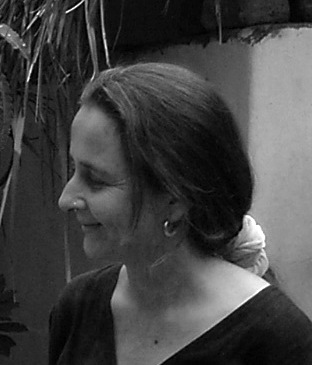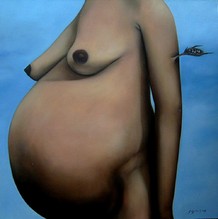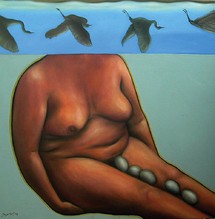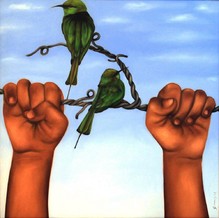
Gayatri Gamuz
Thiruvanamalai, India Born 1966
-
From 01 Aug-2013 To 01 Sep-2013
-
From 01 Apr-2020 To 30 Apr-2020
-
From 01 Jun-2022 To 30 Jun-2022
Fine art painting course completed at the Art School of Alicante (1988); Further fine art painting course completed, Escuela de Ceramica de Manises, Valencia(1991)
†
Selected Solo Exhibitions
'Of the Same Matter', Kashi Art Cafe, Kochin, Kerala (2009); 'In a Land without Trees', Hacienda Gallery, Mumbai (2007); 'In Reverse I tell you so you understand me', Centro Cultural Spain and Lila Gallery, Kochin, Kerala (2006); The Other Within, Centro Civico, Besos Mar, Barcelona (2004); Tenderness in the middle of the rat race, Embassy of India, Berlin, Germany (2004); Pachamama Celebrates 2053, Solo Installation, Lila Studio/Gallery, Kochi, India (2003); 'The Magic Window of Love, Fringe Festival, Brighton, UK (1999); Running Water, Kashi and Dravidia Galleries, Kochi (1999)
†
Selected Group Exhibitions
'This Location', Mojo Art Gallery, Dubai (2010); '6 Person Show', 1 x 1 Art Gallery, Dubai (2010); 'Nothing Will Ever Be The Same Again', Hirji Jehangir Gallery, Mumbai (2009); 'Gender/ Genesis/ Genetics', Gallery Espace, New Delhi (2009); Trends and Trivia: An Indian Story, Hong Kong Visual Arts Centre (2008);Millennium Turks: Envisaging Contemporary India, Trident Hilton Hotel, New Delhi (2008); Garibaldi 200 Years, Museo Storico di Bergamo, Italy and Salon Dorado de la Intendencia Municipal de Montevideo, Uruguay (2008); Ten Light Years, Kashi Art Gallery, Kochi, Kerala (2007); She, India, The Noble Sage Gallery, London (2007); Real 2007, Lalit Kala Akademi, Rabindra Bhavan, New Delhi (2007); Vanity Fair, Mon Art Gallerie, Calcutta (2007); Chronicles of the Unspoken, Travancore Art Gallery, New Delhi (2007); Does Size Matter?, Art Konsult, New Delhi (2007); Instilling Life, Hacienda Gallery, Mumbai (2007); A Slice of Art from India, RL Fine Arts, New York (2007); Stirring Quartet,†† Hacienda Gallery, Mumbai (2006); London Biennale, Stables Gallery, London (2006);Inaugural show Red Wall Gallery, Hobart, Australia (2006); Kastanjeboom houdt Zomersoiree, Nijmegen, Holland (2005); Contemplations, Women Artist Exhibition, Galeria Sara Arakkal, Bangalore (2004); Open Art Project, Die Bank, Munich, Germany (2004)
Spanish-born painter, Gayatri Gamuz, had saved the name Gayatri for her baby daughter. When a son was born she decided to take the name herself; a symbol of her love of her home for the last fifteen years: I feel one with the land in many respects. I dont pretend to belong here or feel that India is mine. I always say that I am a long time tourist in India, even on the planet. When Gamuz moved with her husband to the rural area of Thiruvanamalai seven years ago, a new found synergy with nature created a pronounced shift in her art. Working from photographs, or else excitedly from real life, Gamuz creates hyperrealist paintings that have an instant comprehensibility to the viewer. Comparable to the succinctness of a haiku poem or (perhaps more appropriately because of the humour in her work) likable to a two-line joke where the telling is quick but the after-effect is prolonged, Gamuzs paintings pit together no more than three ideas/forms/items in an often bizarre situation for a continuing edifying message. In her recent series titled In a Land without Trees, a man opens his mouth extraordinarily wide to house a birds nest. In another, a nude woman cups her body to hold bird eggs carefully within. In the third painting, a pregnant woman stands proudly filling the pictorial space. From her thigh a fleshy branch protrudes, a birds nest resting in its perch. The meaning is obvious: in a land without trees, it is the human that must step up and take on this role of natures carer. Gamuz is refreshingly optimistic in her attitude toward mans misuse of his natural surroundings. More poetic and philosophical than ecological, she remarks that though man has the potential for environmental atrocity, he also has the greatest capacity to care like no other creature on the planet. Thus the simple poetry of a man opening his mouth for a bird to shelter, a nude woman trying in vain to mimic the comfort of a nest or a mother-to-be feeling natures rape so greatly that her body morphs to incorporate nature itself, all speaks of one theme: ultimate human sacrifice - both imagined and prophesised.









